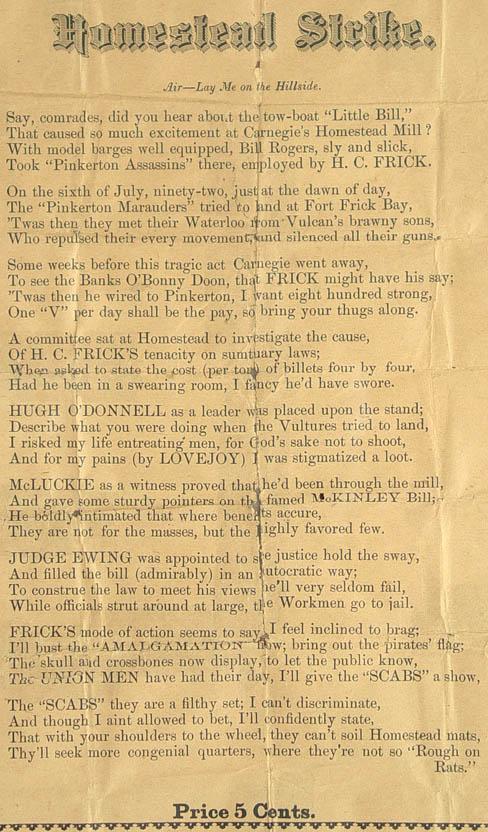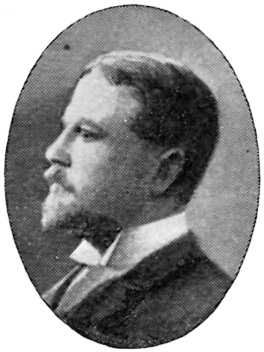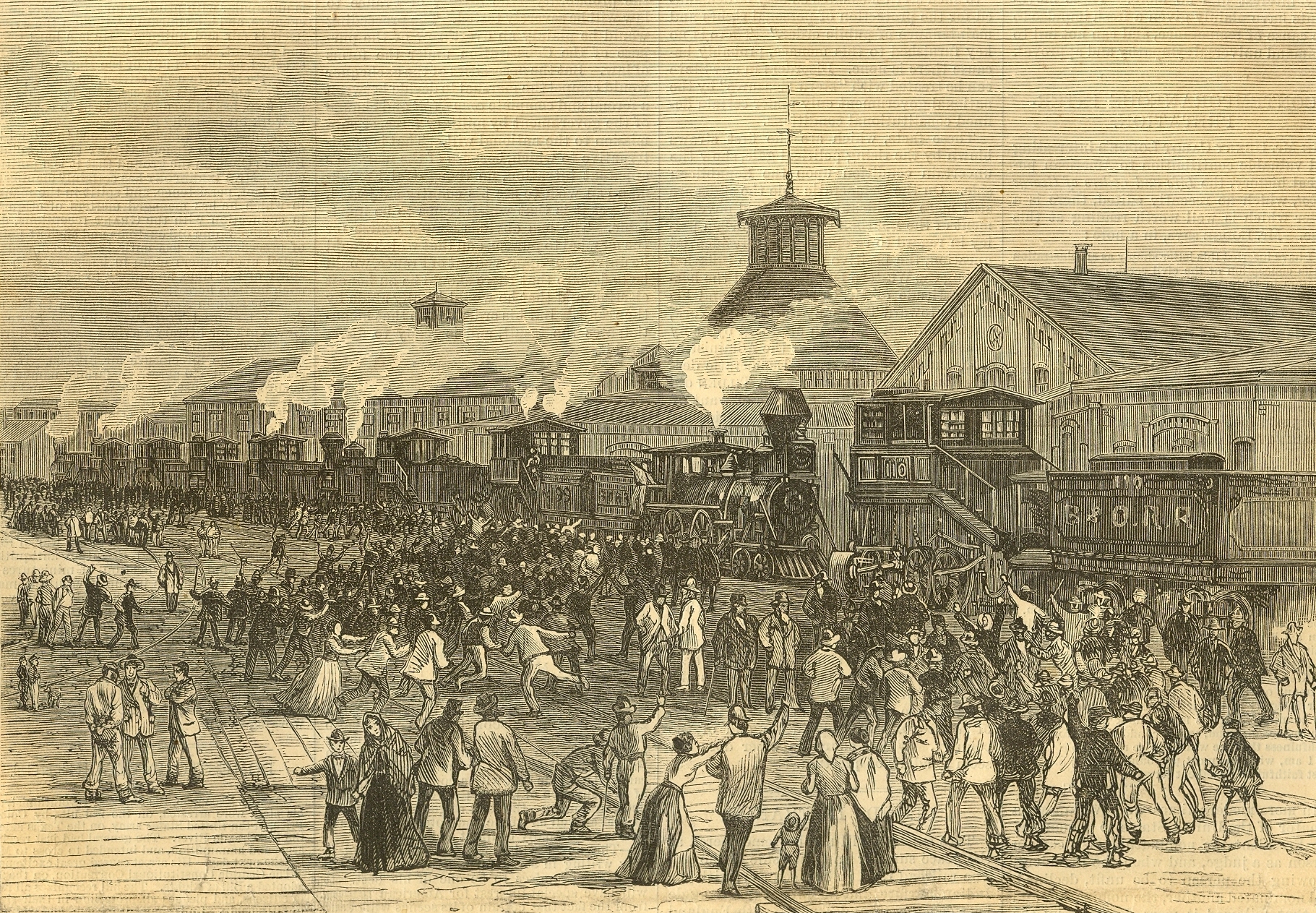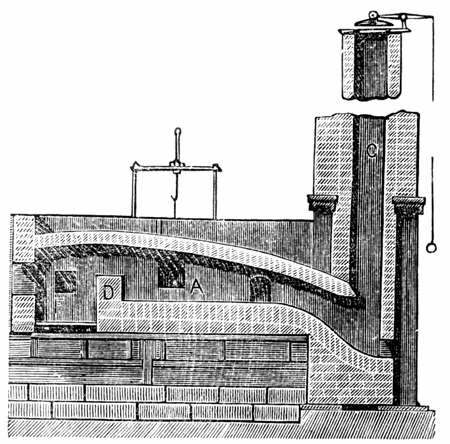|
Homestead Strike
The Homestead strike, also known as the Homestead steel strike, Homestead massacre, or Battle of Homestead, was an industrial lockout and strike that began on July 1, 1892, culminating in a battle in which strikers defeated private security agents on July 6, 1892. The governor responded by sending in the National Guard to protect strikebreakers. The dispute occurred at the Homestead Steel Works in the Pittsburgh-area town of Homestead, Pennsylvania, between the Amalgamated Association of Iron and Steel Workers (the AA) and the Carnegie Steel Company. The final result was a major defeat for the union strikers and a setback of decades for their efforts to unionize steelworkers. The battle was a pivotal event in U.S. labor history. Background Carnegie Steel made major technological innovations in the 1880s, especially the installation of the open-hearth system at Homestead in 1886. It now became possible to make steel suitable for structural beams and for armor plate for ... [...More Info...] [...Related Items...] OR: [Wikipedia] [Google] [Baidu] |
Thure De Thulstrup
Thure de Thulstrup (April 5, 1848 – June 9, 1930), born Bror Thure Thulstrup in Sweden, was a leading American illustrator with contributions for numerous magazines, including three decades of work for ''Harper's Weekly''.'' Dictionary of Literary Biography'' (online edition)Thure de Thulstrup p. 1. Thulstrup primarily illustrated historical military scenes. Background Thulstrup was born in Stockholm, Sweden. His father was Sweden's Secretary of the Navy amongst other such positions. After graduating from the Royal Swedish Military Academy, Thulstrup joined the Swedish military as an artillery officer at the age of twenty. However, he soon left Sweden for Paris, where he joined the French Foreign Legion and saw service in the Franco-Prussian War.''Dictionary of Literary Biography'' (online ed.)Thure de Thulstrup p. 2. Thulstrup also served in the French part of Northern Africa as a member of the First Zouave Regiment. Career After leaving the French Army, Thulstr ... [...More Info...] [...Related Items...] OR: [Wikipedia] [Google] [Baidu] |
Armor Plate
Military vehicles are commonly armoured (or armored; see spelling differences) to withstand the impact of shrapnel, bullets, shells, rockets, and missiles, protecting the personnel inside from enemy fire. Such vehicles include armoured fighting vehicles like tanks, aircraft, and ships. Civilian vehicles may also be armoured. These vehicles include cars used by officials (e.g., presidential limousines), reporters and others in conflict zones or where violent crime is common. Civilian armoured cars are also routinely used by security firms to carry money or valuables to reduce the risk of highway robbery or the hijacking of the cargo. Armour may also be used in vehicles to protect from threats other than a deliberate attack. Some spacecraft are equipped with specialised armour to protect them against impacts from micrometeoroids or fragments of space debris. Modern aircraft powered by jet engines usually have them fitted with a sort of armour in the form of an aramid composi ... [...More Info...] [...Related Items...] OR: [Wikipedia] [Google] [Baidu] |
Great Railroad Strike Of 1877
The Great Railroad Strike of 1877, sometimes referred to as the Great Upheaval, began on July 14 in Martinsburg, West Virginia, after the Baltimore and Ohio Railroad (B&O) cut wages for the third time in a year. This strike finally ended 52 days later, after it was put down by unofficial militias, the National Guard, and federal troops. Because of economic problems and pressure on wages by the railroads, workers in numerous other cities, in New York, Pennsylvania and Maryland, into Illinois and Missouri, also went out on strike. An estimated 100 people were killed in the unrest across the country. In Martinsburg, Pittsburgh, Philadelphia and other cities, workers burned down and destroyed both physical facilities and the rolling stock of the railroads—engines and railroad cars. Local populations feared that workers were rising in revolution such as the Paris Commune of 1871. At the time, the workers were not represented by trade unions. The city and state governments were ai ... [...More Info...] [...Related Items...] OR: [Wikipedia] [Google] [Baidu] |
Jones And Laughlin Steel
The Jones and Laughlin Steel Corporation began as the American Iron Company, founded in 1852 by Bernard Lauth and Benjamin Franklin Jones, a few miles (c 4 km) south of Pittsburgh along the Monongahela River. Lauth's interest was bought in 1854 by James Laughlin. The first firm to bear the name of Jones and Laughlin was organized in 1861 and headquartered at Third & Ross in downtown Pittsburgh. History Originally producing only iron, the enterprise began the production of steel in 1886. Over the ensuing 60 years, the company expanded its facilities and its operations along both sides of the Monongahela River on the South Side of Pittsburgh and along the Ohio River at Aliquippa. The Hot Metal Bridge across the Monongahela River was built to connect Eliza blast furnaces (making pig iron) on the Hazelwood side of the river with the open hearth furnaces (making steel) on the south side of the river. In 1905, a new plant was begun at Aliquippa, Pennsylvania. The company a ... [...More Info...] [...Related Items...] OR: [Wikipedia] [Google] [Baidu] |
Townspeople
The bourgeoisie ( , ) is a social class, equivalent to the middle or upper middle class. They are distinguished from, and traditionally contrasted with, the proletariat by their affluence, and their great cultural and financial capital. They are sometimes divided into a petty (), middle (), large (), upper (), and ancient () bourgeoisie and collectively designated as "the bourgeoisie". The bourgeoisie in its original sense is intimately linked to the existence of cities, recognized as such by their urban charters (e.g., municipal charters, town privileges, German town law), so there was no bourgeoisie apart from the citizenry of the cities. Rural peasants came under a different legal system. In Marxist philosophy, the bourgeoisie is the social class that came to own the means of production during modern industrialization and whose societal concerns are the value of property and the preservation of capital to ensure the perpetuation of their economic supremacy in soc ... [...More Info...] [...Related Items...] OR: [Wikipedia] [Google] [Baidu] |
Strikebreakers
A strikebreaker (sometimes called a scab, blackleg, or knobstick) is a person who works despite a strike. Strikebreakers are usually individuals who were not employed by the company before the trade union dispute but hired after or during the strike to keep the organization running. Strikebreakers may also refer to workers (union members or not) who cross picket lines to work. The use of strikebreakers is a worldwide phenomenon; many countries have passed laws outlawing their use to give more power to unionized workers. , strikebreakers were used far more frequently in the United States than in other industrialized countries. International law The right to strike is not expressly mentioned in any convention of the International Labour Organization (ILO) the ILO's Freedom of Association Committee established principles on the right to strike through rulings. Among human rights treaties, only the International Covenant on Economic, Social and Cultural Rights contains a clause ... [...More Info...] [...Related Items...] OR: [Wikipedia] [Google] [Baidu] |
Yellow-dog Contract
A yellow-dog contract (a yellow-dog clause of a contract, also known as an ironclad oath) is an agreement between an employer and an employee in which the employee agrees, as a condition of employment, not to be a member of a labor union. In the United States, such contracts were, until the 1930s, widely used by employers to prevent the formation of unions, most often by permitting employers to take legal action against union organizers. In 1932, yellow-dog contracts were outlawed in the United States under the Norris-LaGuardia Act. Origin of term and brief history In the 1870s, a written agreement containing a pledge not to join a union was commonly referred to as the "Infamous Document." This strengthens the belief that American employers in their resort to individual contracts were consciously following English precedents. This anti-union pledge was also called an "iron clad document," and from this time until the close of the 19th century "iron-clad" was the customary name ... [...More Info...] [...Related Items...] OR: [Wikipedia] [Google] [Baidu] |
Puddling (metallurgy)
Puddling is the process of converting pig iron to bar (wrought) iron in a coal fired reverberatory furnace. It was developed in England during the 1780s. The molten pig iron was stirred in a reverberatory furnace, in an oxidizing environment, resulting in wrought iron. It was one of the most important processes of making the first appreciable volumes of valuable and useful bar iron (malleable wrought iron) without the use of charcoal. Eventually, the furnace would be used to make small quantities of specialty steels. Though it was not the first process to produce bar iron without charcoal, puddling was by far the most successful, and replaced the earlier potting and stamping processes, as well as the much older charcoal finery and bloomery processes. This enabled a great expansion of iron production to take place in Great Britain, and shortly afterwards, in North America. That expansion constitutes the beginnings of the Industrial Revolution so far as the iron industry is co ... [...More Info...] [...Related Items...] OR: [Wikipedia] [Google] [Baidu] |
Hiring Hall
In organized labor, a hiring hall is an organization, usually under the auspices of a labor union, which has the responsibility of furnishing new recruits for employers who have a collective bargaining agreement with the union. It may also refer to a ''union hall,'' or the office from which the union may conduct its activities. The employer's use of the hiring hall may be voluntary, or it may be compulsory by the terms of the employer's contract with the union (or, in a few cases, the labor laws of the jurisdiction in question). Compulsory use of a hiring hall effectively turns employers into a ''closed shop'' because employees must join the union before they can be hired. This is the primary argument against the practice, since it disallows non-union workers to gain employment. Arguments in favor of the institution include that the presence of a hiring hall places the responsibility on the union to ensure that its members are suitably qualified and responsible individuals before ... [...More Info...] [...Related Items...] OR: [Wikipedia] [Google] [Baidu] |
Allegheny Mountains
The Allegheny Mountain Range (; also spelled Alleghany or Allegany), informally the Alleghenies, is part of the vast Appalachian Mountain Range of the Eastern United States and Canada and posed a significant barrier to land travel in less developed eras. The Allegheny Mountains have a northeast–southwest orientation, running for about from north-central Pennsylvania, southward through western Maryland and eastern West Virginia. The Alleghenies comprise the rugged western-central portion of the Appalachians. They rise to approximately in northeastern West Virginia. In the east, they are dominated by a high, steep escarpment known as the Allegheny Front. In the west, they slope down into the closely associated Allegheny Plateau, which extends into Ohio and Kentucky. The principal settlements of the Alleghenies are Altoona, State College, and Johnstown, Pennsylvania; and Cumberland, Maryland. Name The name is derived from the Allegheny River, which drains only a small ... [...More Info...] [...Related Items...] OR: [Wikipedia] [Google] [Baidu] |
Ironworks
An ironworks or iron works is an industrial plant where iron is smelted and where heavy iron and steel products are made. The term is both singular and plural, i.e. the singular of ''ironworks'' is ''ironworks''. Ironworks succeeded bloomeries when blast furnaces replaced former methods. An integrated ironworks in the 19th century usually included one or more blast furnaces and a number of puddling furnaces or a foundry with or without other kinds of ironworks. After the invention of the Bessemer process, converters became widespread, and the appellation steelworks replaced ironworks. The processes carried at ironworks are usually described as ferrous metallurgy, but the term siderurgy is also occasionally used. This is derived from the Greek words ''sideros'' - iron and ''ergon'' or ''ergos'' - work. This is an unusual term in English, and it is best regarded as an anglicisation of a term used in French, Spanish, and other Romance languages. Historically, it is com ... [...More Info...] [...Related Items...] OR: [Wikipedia] [Google] [Baidu] |
Craft Unionism
Craft unionism refers to a model of trade unionism in which workers are organised based on the particular craft or trade in which they work. It contrasts with industrial unionism, in which all workers in the same industry are organized into the same union, regardless of differences in skill. Under this approach, each union is organized according to the craft, or specific work function, of its members. For example, in the building trades, all carpenters belong to the carpenters' union, the plasterers join the plasterers' union, and the painters belong to the painters' union. Each craft union has its own administration, its own policies, its own collective bargaining agreements and its own union halls. The primary goal of craft unionism is the betterment of the members of the particular group and the reservation of job opportunities to members of the union and those workers allowed to seek work through the union's hiring hall. Origins The first unions established in Russia in the ea ... [...More Info...] [...Related Items...] OR: [Wikipedia] [Google] [Baidu] |








